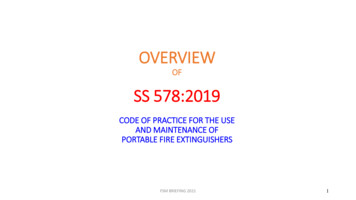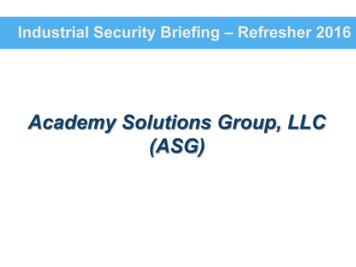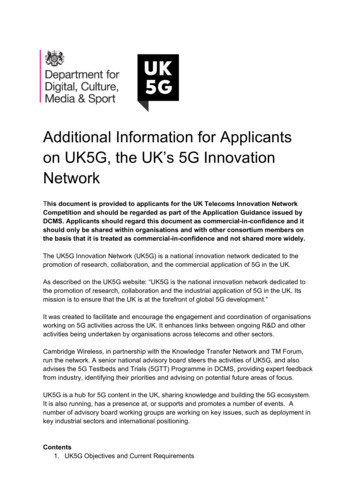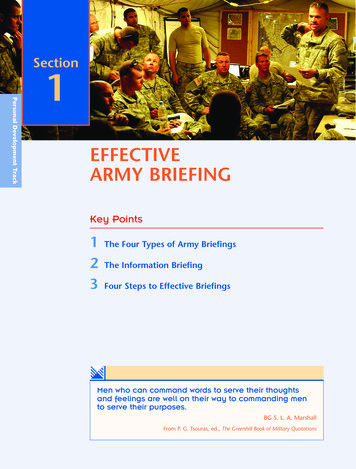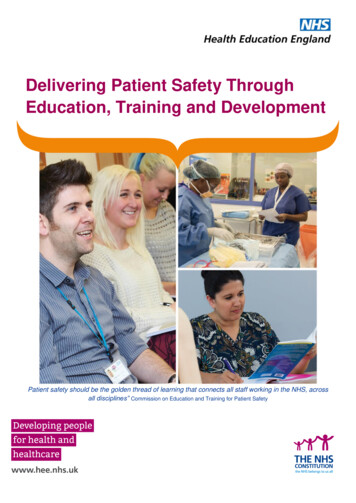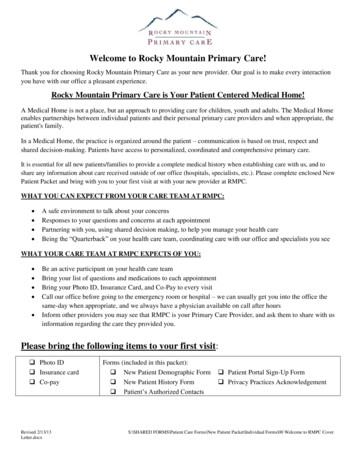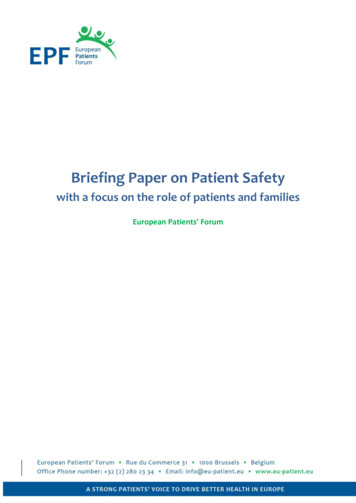
Transcription
Briefing Paper on Patient Safetywith a focus on the role of patients and familiesEuropean Patients’ Forum
Table of ContentsIntroduction . 3What is patient safety and why does it matter?. 3Patient safety as a systems issue . 5Patient safety culture . 6Addressing patient safety at the European Union level . 7The legal framework . 8EU collaboration and exchange of good practices . 9EPF’s focus on patient safety . 10The patients’ role in patient safety . 11Conclusions and next steps . 15Further information . 17Annex: Key terms . 182EPF Briefing Paper on Patient Safety
IntroductionPatient safety has been a priority for EPF since the founding of our organisation. EPF believesthat patient safety is everyone’s business. Patient safety goes to the heart of the work forequitable patient-centred healthcare across EU. The EPF Strategic Plan 2014-2020 focuses onsafety within a broader approach of patient-centred healthcare under one of the six strategicgoals.GOAL 2: Healthcare Access and QualityTo contribute to improvements in health systems that enableequitable access to sustainable and high-quality healthcaredesigned and delivered to meet patients’ and informal carers’ needsat all levels of care, embracing innovation in all its forms.Among the key actions to reach this goal, EPF is working to identify solutions to makehealthcare systems more sustainable while preserving and strengthening health services’quality, safety and equitable access for all patients.This paper provides a background for EPF’s members and other interested parties on patientsafety as an important dimension of quality of care, how this has been addressed in EU policy,and EPF’s involvement at EU level. It stresses the importance of patients’ empowerment andinvolvement in improving safety, and some of the challenges involved in realising that.Please note that this paper deals with the general concept of patient safety in the healthcareenvironment. There are specific issues around the safety of medicines and devices, safety ofinjections and surgeries, hand hygiene, blood safety, antibiotic resistance, etc. However,these topics require lengthy discussion that goes beyond the scope of this briefing paper.1This paper also does not address negligence or malpractice (see “Annex: key terms”, p. 18).What is patient safety and why does it matter?Patient safety is the foremost attribute of quality of care as defined by the World HealthOrganization (WHO).2 It is both a goal (a state of being that is free from unnecessary harm)and a practice (processes and structures that aim to make healthcare safer).1On medication errors, see the European Medicines Agency on this topic and on pharmacovigilance. On otherselected patient safety issues, please see http://www.who.int/topics/patient safety/en/. See also EPF’s workon pharmacovigilance, falsified medicines, and other medicines and medical devices-related topics, onwww.eu-patient.eu .2Care that is effective, efficient, accessible, acceptable/patient-centred, equitable and safe. See Quality ofcare: a process for making strategic choices in health systems. WHO, 2006. pp. ityCare B.Def.pdf3EPF Briefing Paper on Patient Safety
These definitions of patient safety capture both aspects:Patient safety: “the absence of preventable harm to a patient during the process of health care”[The process or discipline of] patient safety: “the coordinated efforts to prevent harm, caused bythe process of health care itself, from occurring to patients”.3Safety covers every event that may occur in hospital settings but also in any other healthcaresettings, including primary care, nursing homes, or patients’ homes. Some examples includeharm caused as a result of a wrong diagnosis, wrong clinical decision or intervention, wrongdose of medicine, side-effects of medicines or other treatments, hazards posed by substandard products, human and system failures.Data on medical errors and adverse events in23% of Europeans were directlyhealthcare show that despite an intense focusaffected by medical erroron this topic for more than a decade, the levelsof incidents have not reduced as much as we 18% experienced a serious medicalwould wish.4,5 The WHO estimates that as error in hospitalmany as one in 10 patients is harmed while11% were prescribed the wrongreceiving hospital care in developed countries.medicationThe number is higher in less developed(Eurobarometer, January 2006)countries. At any time, 1.4 million peopleworldwide suffer from infections acquired inhospitals.6Such figures have an impact on patients’ trust inMedical errors and healthcare- the healthcare system, with around 50% of EUrelated adverse events occurred citizens believing there is a risk of being harmedin 8–12% of hospitalisations in by hospital care. Of them 9% feel this is verylikely, and 41% fairly likely. Almost the sameEurope.(RAND Europe, 2009) numbers felt it was very or fairly likely that theycould be harmed in nonhospital care.7Unsafe care has not only consequences for patients’ health and well-being, but also animportant economic impact, as revealed in the literature review by the PaSQ Joint Action.8 It3World Health Organisation, WHO Draft Guidelines for Adverse Event Reporting and Learning Systems, 2005.Medical Errors. Special Eurobarometer, January 2006. European Commission,http://ec.europa.eu/public opinion/archives/ebs/ebs 241 en.pdf5Conklin, A. Room for improvement; Strong patient safety systems could limit health, social and economicharms from medical error. RAND Europe, arch briefs/2009/RAND RB9472.pdf6"Ten facts about patient safety” at www.who.int7Special Eurobarometer 327, Patient safety and quality of healthcare, April 2010. European Commission,http://ec.europa.eu/public opinion/archives/ebs/ebs 327 en.pdf8Taofikat Agbabiaka, José Joaquín Mira, Martina Lietz, Valentina Hafner and Bruce Warner. A literature basedanalysis of the cost of adverse events to Europe, PaSQ project, 2013.44EPF Briefing Paper on Patient Safety
is estimated that out of the complications due to adverse events identified in 9% of hospitaladmissions, 44% may be preventable. An estimated 43 million hospitalisation-related adverseevents worldwide each year result in 23 million DALYs (disability-adjusted life years, i.e. theyears of life lost to disability). The study on whose basis the estimation was done confirmedthat preventable adverse events are leading causes of illness and death worldwide, and extrastays in hospital caused by adverse events in the EU and Norway account for some 3.5 millionDALYs. Translated into money, the estimated additional cost from preventable adverse eventswould be 13.7 billion (in 2013).Patient safety as a systems issueSafety incidents in healthcare are often not attributable to only one error, but happen as aresult of a “sum of vulnerabilities”.9 An illustration of this kind of system failure in theliterature is the so-called “Swiss Cheese Model”10 which shows how adverse events arecaused by a combination of system failures and human errors. In the model, the system isrepresented by slices of cheese, which normally will be aligned in such a way that the holesdo not overlap. Therefore, a safety risk might happen at one layer, but it will be stopped bythe next one.The Swiss Cheese Model(Source: http://patientsafetyed.duhs.duke.edu/module e/swiss cheese.html)In real life, each “layer” has its vulnerabilities which may result in a safety risk for patients.Examples of such vulnerabilities might be a lack of medical materials, poor communicationwithin the care team, or between the care team and management, lack of updated knowledgeor skills of the professionals involved, poor procedures, lack of personnel, overworked staff,lack of supervision, and so on.9World Health Organisation, “WHO Draft Guidelines for Adverse Event Reporting and Learning Systems”,2005.10Source for the illustration: “Swiss Cheese” Model – James Reason, 1991. The book reference is: Reason, J.(1990) Human Error. Cambridge: University Press, Cambridge. An example of sequential errors as described inthe Swiss Cheese Model is available here: http://patientsafetyed.duhs.duke.edu/popup/module e/swiss cheese.html5EPF Briefing Paper on Patient Safety
Over the years it has become evident that “adverse events occur not because bad peopleintentionally hurt patients but rather that the system of health care today is so complex thatthe successful treatment and outcome for each patient depends on a range of factors, notjust the competence of an individual health-care provider.”11In light of this, addressing safety from a patient perspective is to ensure that the healthcareorganisation/system takes all possible measures to prevent vulnerabilities in the care process,communicates openly about errors and “near-miss” situations, analyses them and uses thoseexperiences as continuing learning tools to improve safety. Patients and patient organisationsshould be involved in these processes and in all aspects of the care continuum, to the extentthat they wish to be.Patient safety cultureThe traditional approach to patient safety incidents stressed putting blame on the individualhealth professionals and their errors. This is referred to as “blame culture”. It is human natureto wish to identify someone who is to blame; and people tend to believe that punishmentworks to prevent future incidents. It may also be the only possibility for patients or theirfamilies to obtain compensation if there is no “blame-free” system of compensation in place.However, “[s]ystemic improvements cannot be made as long as we focus on blamingindividuals. This willingness to assign blame is thought to be one of the main constraints onthe health system’s ability to manage risk and improve care.”12As far back as 1999, the ground-breaking report To Err is Human recognised that most medicalerrors are the result of unavoidable human error, and that punishment would not reducefuture errors but might achieve the opposite by providing a perverse incentive forprofessionals to stay silent. “The focus must shift from blaming individuals for past errors toa focus on preventing future errors by designing safety into the system. This does not meanthat individuals can be careless. People must still be vigilant and held responsible for theiractions. But when an error occurs, blaming an individual does little to make the system saferand prevent someone else from committing the same error.”13The key to addressing errors in a healthcare system (which could be an organisation, a unit ora team) is therefore to promote a patient safety on/curriculum/who mc topic-1.pdfWHO educational information sheet, “What is patient on/curriculum/course1 handout.pdf13To Err Is Human. Building a Safer Health System. Executive summary. Kohn LT, Corrigan JM and DonaldsonMS, editors. Committee on Quality of Health Care in America, Institute of Medicine, National Academy Press,Washington, DC, 1999. Available to read online at http://www.nap.edu/read/9728/chapter/1126EPF Briefing Paper on Patient Safety
One definition of patient safety culture was developed in the EUNETPAS project, in which EPFwas a partner:“An integrated pattern of individual and organisational behaviour, based upon shared beliefs andvalues that continuously seeks to minimise patient harm, which may result from the processes ofcare delivery.”14Another useful definition is:“A safety culture is where staff within an organisation have a constant and active awareness ofthe potential for things to go wrong. Both the staff and the organisation are able to acknowledgemistakes, learn from them, and take action to put things right.To reduce the likelihood of incidents occurring, patient safety needs to be addressed at aninstitutional level, ‘from trust board to ward’, as well as by designing out errors in processes andequipment.”15Building a patient safety culture might require changing the attitudes of professionals,developing teamwork, translating research evidence into practice, considering patients aspartners in the healthcare process (to the extent they can and wish to participate) andensuring that expectations for outcomes are realistic and in the best interest of patients.Safety culture starts with recognising the possibility of error and ensuring continuous learningand improvement processes are in place. Senior leadership accountability is very importantto build a culture of safety in any organisation.16Addressing patient safety at the European Union levelIn recent years, the European Commission has placed a special focus on quality of care andpatient safety, considering the latter as a specific issue independent from quality of care.However, since 2010 there has been a shift towards addressing quality in a broader sense atEuropean level, with special emphasis on the idea that patient safety is an aspect of quality.This has been increasingly accepted by Member States and its priority was confirmed by thepublic consultation performed as part of the release of the European Commission’s “Patientsafety package” in 2014.14European Society for Quality in Health Care(2006) in EUNETPAS Report on Patient Safety Culture, p. 7available athttp://ns208606.ovh.net/ extranet/images/EUNetPaS Publications/wp1 patient safety culture report focusing on indicators version2.pdf15Source: cs/human-factors-patient-safety-culture16Sammer CE1, Lykens K, Singh KP, Mains DA, Lackan NA. What is patient safety culture? A review of theliterature. J Nurs Scholarsh. 20107EPF Briefing Paper on Patient Safety
The legal frameworkEU collaboration on patient is based on two important reference points, the first being theCouncil Recommendation on Patient Safety including the prevention and control of healthcare associated infections of 2009.17The Council recommendation was developed on the basis of a 2008 CommissionCommunication on patient safety (COM(2008) 836 final), which aimed at supporting MemberStates “to put in place adequate strategies to prevent and control adverse events inhealthcare, including healthcare associated infections, and to improve EU citizens' confidencethat they have sufficient, comprehensive and comprehensible information on safety andavailable redress in EU health systems”.The CR includes a series of specific measures that Member States are expected to implementto improve patient safety. The first part of the Recommendation covers general patient safetyissues and the second part refersThe legal framework on patient safety derivesspecifically to the prevention andfrom the Treaty on the Functioning of thecontrolofhealthcare-associatedEuropean Union (TFEU), whose Article 168infections.EPF has for many years participatedactively in the European Commission’sExpert Group on Patient Safety andQuality of Care and contributed apatients’ perspective to the CommissionCommunication and the subsequentCouncil Recommendation. The lattercontains a special section requiringMember States to inform and empowerpatients and citizens, and for MemberStates to involve patient organisationsin the development of policies andprogrammes at national level.However, in terms of implementation,the Commission identified patientinvolvement and empowerment as oneof the less implemented areas of the CRin its progress reports of 2012 and still in2014. Other poorly implemented areas17stipulates that a high-level of health protectionmust be ensured in all EU policies and activities.Different types of legislation derive from the EUcompetencies as set out in the Treaties: in areaswhere the EU has no clear powers to pass bindinglegislation, it relies on so-called “soft law”(Recommendations and Communications) andmutual collaboration/exchange of best practices.Patient safety is such an area, as the responsibilityfor organisation of health systems and delivery ofhealthcare remains with the Member States. TheCR is therefore not legally binding, butnevertheless has quite a lot of political weightespecially since its application has been monitoredby the Commission.The EU can pass directives or regulations toharmonise Member States' laws only in specificareas defined in Article 168(4) TFEU, which includethe safety and quality of pharmaceuticals, medicaldevices, blood, tissues and cells of human origin.The cross-border healthcare is a directive becauseit has a dual legal basis, deriving both from Art. 168and from internal market legislation (Art. 114).http://ec.europa.eu/health/patient safety/docs/council 2009 en.pdf8EPF Briefing Paper on Patient Safety
are reporting and learning systems, and embedding patient safety in the education andtraining of professionals.The second, more recent, reference point for patient safety is the EU Directive on theapplication of patients’ rights in cross-border healthcare (Directive 2011/24/EU).18 TheDirective contains important provisions regarding quality and safety of healthcare. Forexample, it requires Member States to provide cross-border healthcare in accordance withapplicable safety and quality standards and guidelines, to provide information to patients onthose standards and guidelines, and to collaborate with each other on the development ofthese. For more information please refer to EPF’s extensive policy work on cross-borderhealthcare, available on our website.19EU collaboration and exchange of good practicesThe collaborative approach in patient safety and quality of care, focusing on exchange ofinformation and sharing of good practices, has been driven mainly by projects co-fundedunder the EU Health Programme involving Member States and EU stakeholder organisations.The European Union Network on Excerpt from the 2009 Council RecommendationPatient Safety and Quality of Care[Recommends that Member States](PaSQ) was a Joint Action in which“2. Empower and inform citizens and patients by:EPF was an associate partner. The(a) involving patient organisations and representatives inJoint Action ran from April 2012the development of policies and programmes on patientuntil March 2016. The project’ssafety at all appropriate levels;objectives were to support(b) disseminating information to patients on:MemberStatesinthe(i) patient safety standards which are in place;implementation of the Council(ii) risk, safety measures which are in place toRecommendation; initiate coreduce or prevent errors and harm, includingoperation on quality of healthcare;best practices, and the right to informed consentand facilitate the sharing of goodto treatment, to facilitate patient choice andpractices in patient involvement.decision-making;PaSQ served to further strengthen(iii) complaints procedures and availableco-operation between EU Memberremedies and redress and the terms andStates, international organisationsconditions applicable;and EU stakeholders on issues ”related to quality of healthcare,including patient safety. The Joint Action mapped and identified existing good practices inpatient safety and quality of care from across the EU, analysed them for evidence-base v.do?uri OJ:L:2011:088:0045:0065:en:PDFFor example, the EPF guidance document for patient organisations (2012), position paper (2015) and reportsfrom our series of regional conferences, available at obility/199EPF Briefing Paper on Patient Safety
transferability, and also supported the implementation of a selection of proven goodpractices in some Member States.20The PaSQ Joint Action built on the experience of a previous project under the healthprogramme, EUNetPaS (2008-2010) which had led to the establishment of patient safetyplatforms in several Member States. In that project, EPF was also involved and contributed tothe development of A Guide for Education and Training in Patient Safety.21EPF’s focus on patient safetyAs mentioned in the introduction, patient safety is a core priority for EPF and we are highlyactive in this field. In addition to the contributions mentioned above, through the EuropeanCommission’s Expert Group, EUNetPaS and PaSQ, we have worked closely with internationalorganisations and stakeholders on patient safety-related topics.EPF has long advocated for more action at EU level on quality of care and for the vitalimportance of the patients’ perspective in defining quality. In 2010, EPF contributed to thedraft Commission reflection paper “Quality of healthcare: policy actions at EU level”, whichemphasised the importance of patient-centred healthcare and recognised patientinvolvement as a cross-cutting theme with relevance to most elements of healthcarequality.22 In February 2014 EPF responded to the public consultation launched by DG Sante(then SANCO) to explore the priority areas on patient safety and quality of care at EU level,including whether quality of healthcare should be given more importance in the future.EPF has also collaborated with the WHO Regional Office for Europe, in our role as the EU-levelumbrella patient organisation, in the area of patient safety. In 2007, we reviewed thedocument “National health system quality and safety strategies: guidance for WHO Europemember states”, stressing the importance of the need to provide adequate resources forpatient organisations in order to enable them to participate in a meaningful way in safety andquality interventions.In November 2010, we participated in a new initiative on “Patient safety and patients’ rights”,which explored linkages between patient safety and patients’ rights, and particularly thepossibilities to improve patient safety by enhancing patient empowerment and healthliteracy. EPF contributed in a workshop and reviewed the report resulting from this project,which was published by WHO in 2013.23We have consulted our membership on several occasions on their priorities and perceptions20See the Joint Action website: www.pasq.euFor more information see mission draft reflection paper no. 9366/10, page 7 (March 2010)23Exploring patient participation in reducing health-care-related safety risks. Available atwww.euro.who.int/ data/assets/pdf file/0010/185779/e96814.pdf2110EPF Briefing Paper on Patient Safety
regarding patient safety. Our membership survey in 2012-13 focused on checking awarenessof the existence of EU recommendations in this field; patient organisations’ involvement; andpriorities identified by patient organisations at national level. The findings showed that Slightly more than half of the respondents (58%) knew about the CRNevertheless many had some role in developing patient safety information orparticipating in consultations in their countryPatient involvement was seen as a poorly implemented area of safetyEPF was by far the most common source of information on EU recommendations(80%), followed by patient organisations at national level (13%)Patient organisations did not receive much information from their national bodiesPatient organisations were seen as important source of capacity-building for patientsin patient safety.The patients’ role in patient safetyThe Commission’s second implementation report on patient safety (2014) recognised that theexperiential knowledge of patients and families is a valuable resource for health professionalsand that this experience should be gathered as an element of quality improvement systems.Patients’ involvement is also vital for instilling a patient safety culture in the healthcaresystem.24EPF would like to see patient organisations takea more active stance on patient safety at policylevel. Nevertheless, we acknowledge thechallenges related to individual patients’involvement in this area and the need forempowerment.Seven Steps to Patient Safety1.2.3.4.5.6.7.Safety cultureLead & support staffIntegrated risk managementPromote incident reportingInvolve patients and the publicLearn and share lessonsImplement solutionsPatients play a vital role in the management ofchronic conditions. They live with their conditionevery day and become experts through livedSource: NHS (UK) National patient safetyexperience, on the condition itself and its impactagency – guidance document (2004)on their life, the impact of treatments, and thepositive aspects as well as failures of the healthcare system which they rely on a regular basis.Supporting and promoting the meaningful involvement of patients, both individually andcollectively in improving patient safety, is one of the priorities for EPF. “Meaningful patient24Reports of sub-groups of the PSQC WG on education in patient safety and reporting-learning systems, April2014. Available at http://ec.europa.eu/health/patient safety/policy/package en.htm11EPF Briefing Paper on Patient Safety
involvement” as defined by EPF25 is based on the premise that patients have a specificexpertise derived from lived experience – simply from being patients, which is a valuablesource of experiential knowledge. The patient’s perspective is not the same as thelay/consumer perspective. The patient’s knowledge is derived from living with a conditionday-to-day and from being in frequent contact with the healthcare system.For the PASQ Joint Action, the following definition of patient involvement was developed onthe basis of Value :Patient involvement refers to “the extent to which patients and their families or caregivers,whenever appropriate, participate in decisions related to their condition (e.g. through shareddecision-making, self-management) and contribute to organisational learning through theirspecific experience as patients (e.g. patient reporting of adverse events or participation in rootcause analysis related to their care).Collective patient/public involvement is the extent to which patients and citizens, through theirrepresentative organisations, contribute to shaping the health care system through involvementin health care policy-making, organisation and delivery.”26Let us deal with collective involvement first. At collective level, patient organisations play arole in informing and educating the patient community as well as conveying patient feedbackto health professionals. They are effective at advocacy, with direct and regular contacts withtheir grass-roots community. Through channelling their members’ direct experiences, patientorganisations are able to represent their views and concerns at health policy level, ensuringthat health services are developed with the patient at the centre and that they meet thepatients’ real needs and preferences.Through advocacy and participation in health policy making, patients and patientorganisations can be involved in shaping healthcare systems to be more patient friendly andempowering to patients. Levels of meaningful involvement are often illustrated by the“ladder” model first developed by Arnstein in 196927 (see illustration, below). This model hasbeen variously adapted, including for patient involvement in research by the PatientParnerproject.28At individual level, patients can contribute by getting actively involved in their care. Theirexperience of their healthcare journey is a rich resource of information and learnings aboutgaps and failures in the system and can function as a “last safety barrier”. Patients observe25“Patients take an active role in activities or decisions that will have consequences for the patient community,because of their specific knowledge and relevant experience as patients. The involvement must be planned,appropriately resourced, carried out, and evaluated as to its outcomes, impact and the process itself,according to the values and purposes of all participants.” (EPF project “VALUE ”, 2009).26European Patients Forum for PaSQ project, adapted from the Value project27Arnstein, Sherry R. "A Ladder of Citizen Participation," JAIP, Vol. 35, No. 4, July 1969, pp. 216-224. Accessedat f-citizen-participation.html28PatientPartner (2010) project funded under EU FP7. www.patientpartner-europe.eu12EPF Briefing Paper on Patient Safety
much during their journey; health professionals should take this seriously, give patientsopportunities to speak, listen to what they have to say, and take action.An important caveat regarding individualpatients’ involvement is that each person’sindividual circumstances and preferences shouldalways be respected. Some patients do not wishto get involved. Patients are already burdenedwith having a disea
As far back as 1999, the ground-breaking report To Err is Human recognised that most medical errors are the result of unavoidable human error, and that punishment would not reduce . 13 To Err Is Human. Building a Safer Health System. Executive summary. Kohn LT, Corrigan JM and Donaldson

